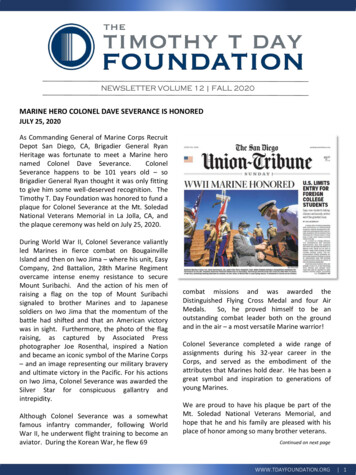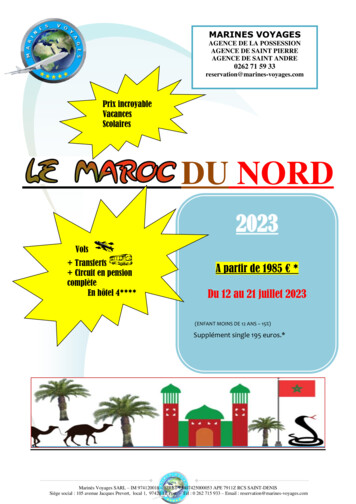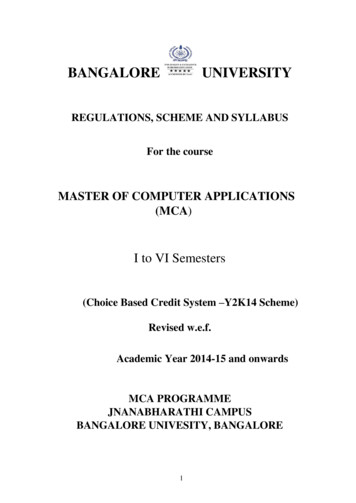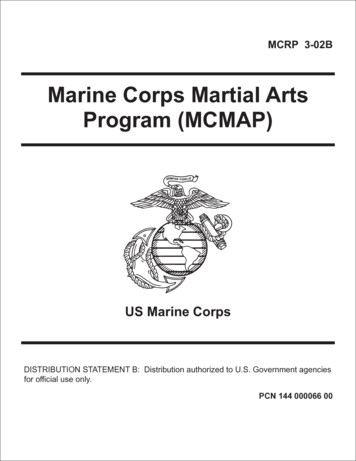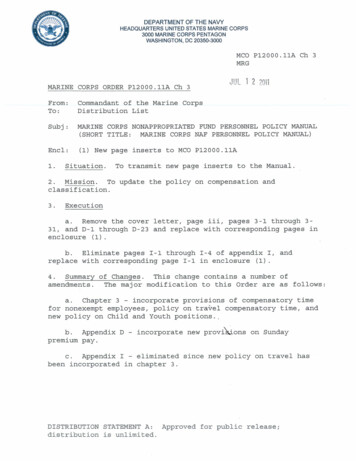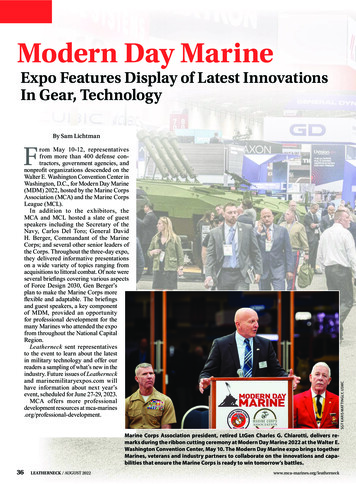
Transcription
Modern Day MarineExpo Features Display of Latest InnovationsIn Gear, TechnologyBy Sam LichtmanFSGT KARIS MATTINGLY, USMCrom May 10-12, representativesfrom more than 400 defense contractors, government agencies, andnonprofit organizations descended on theWalter E. Washington Convention Center inWashington, D.C., for Modern Day Marine(MDM) 2022, hosted by the Marine CorpsAssociation (MCA) and the Marine CorpsLeague (MCL).In addition to the exhibitors, theMCA and MCL hosted a slate of guestspeakers including the Secretary of theNavy, Carlos Del Toro; General DavidH. Berger, Commandant of the MarineCorps; and several other senior leaders ofthe Corps. Throughout the three-day expo,they delivered informative presentationson a wide variety of topics ranging fromacquisitions to littoral combat. Of note wereseveral briefings covering various aspectsof Force Design 2030, Gen Berger’splan to make the Marine Corps moreflexible and adaptable. The briefingsand guest speakers, a key componentof MDM, provided an opportunityfor professional development for themany Marines who attended the expofrom throughout the National CapitalRegion.Leatherneck sent representativesto the event to learn about the latestin military technology and offer ourreaders a sampling of what’s new in theindustry. Future issues of Leatherneckand marinemilitaryexpos.com willhave information about next year’sevent, scheduled for June 27-29, 2023.MCA offers more professionaldevelopment resources at mca-marines.org/professional-development.Marine Corps Association president, retired LtGen Charles G. Chiarotti, delivers remarks during the ribbon cutting ceremony at Modern Day Marine 2022 at the Walter E.Washington Convention Center, May 10. The Modern Day Marine expo brings togetherMarines, veterans and industry partners to collaborate on the innovations and capabilities that ensure the Marine Corps is ready to win tomorrow’s battles.36LEATHERNECK / AUGUST 2022www.mca-marines.org/leatherneck
STEPHEN COLLINSSGT KARIS MATTINGLY, USMCA Marine demonstrates the use of a virtual reality (VR) headset at ModernDay Marine 2022. VR and similar technologies have been evaluated for useas training aids.Above: LtGen David Bellon, the commander ofMarine Forces Reserve and Marine Forces South,participates in a panel discussion on partnershipsin littoral operations during Modern Day Marine2022 at the Walter E. Washington ConventionCenter, Washington, D.C., May 11.STEPHEN COLLINSLeft: Gen Eric M. Smith, center, the AssistantCommandant of the Marine Corps, joinsrepresentatives of the MCA and the Marine CorpsLeague to cut the ceremonial ribbon opening theModern Day Marine 2022 expo at the Walter E.Washington Convention Center, May 10.www.mca-marines.org/leatherneckAUGUST 2022 / LEATHERNECK37
LCPL RYAN RAMSAMMY, USMCMarines with Bravo Company, 2nd Marine Regiment, 2nd Marine Division,operate a Hunter WOLF Vehicle System down a mountain during trainingon Camp Dawson, W.Va., Feb. 5.HDT Global Hunter WOLF38LEATHERNECK / AUGUST 2022NANCY S. LICHTMANRight: Demonstrating its capability as alogistics vehicle, this version of HunterWOLF carries water and fuel containers.Small, unmanned vehicles like this onecould help sustain dismounted infantryin areas inaccessible by trucks or aircraft.NANCY S. LICHTMANUnmanned vehicles seem to be a popular technology amongsome of the larger companies in the defense industry. Amongothers, HDT Global had two examples of their Hunter WOLF(Wheeled Offload Logistics Follower) unmanned groundvehicle on display. The Hunter WOLF is a small six-wheeledground vehicle with a hybrid powertrain running on electricitywith a diesel generator for charging the battery; it is designedto support an infantry squad in any terrain or climate. Thevehicle’s compact dimensions allow it to be airlifted to combatzones; a V-22 Osprey is able to carry two of them and theArmy’s CH-47 is able to carry six. Its modular design and 1-tonpayload capacity allow Marines to convert the Hunter WOLFbetween a wide variety of configurations. HDT had one set upas a logistics vehicle and another with a remote weapons systemat Modern Day Marine; other payload packages are designedfor reconnaissance, engineering, and even anti-tank missions.The vehicle is controlled using a small wireless remote orcan even be set to autonomously follow dismounted infantry.The Hunter WOLF has seen use in the Australian Outbackas a sort of robotic farmhand, allowing oneremote operator to safely and comfortablyperform the work of many people in lesstime. The Marine Corps is currently testingtethered quadcopters powered by theHunter WOLF’s onboard generator. Moreinformation is available at hdtglobal.com/series/hunter-wolf/.Above: To show the sizeand scale of the vehicle,Leatherneck writer, SamLichtman, stands next toan HDT Hunter WOLF withremote weapons station,built by FN America. TheHunter WOLF can supporta diverse array of payloads,making it adaptable to therequirements of almostany mission.www.mca-marines.org/leatherneck
Marines with 1st Battalion, 2nd Marine Regiment, 2nd MarineDivision, rehearse medical evacuation scenarios with an Expeditionary Modular Autonomous Vehicle (EMAV) during a trainingevent on MCB Camp Lejeune, N.C., June 24, 2021. The EMAV is ahighly mobile and fully autonomous ground vehicle.NANCY S. LICHTMANOshkosh Defense also brought an unmanned ground vehicleto the show. In development for six years by their subsidiaryPratt Miller Defense in conjunction with QinetiQ, the EMAV(Expeditionary Modular Autonomous Vehicle) is much largerand more than twice as heavy as the Hunter WOLF but retainsa similar low profile. It travels on rubber tracks at more than 50miles per hour over flat ground and can be carried internallyaboard the V-22 Osprey and other military transport aircraft.The EMAV can be rapidly reconfigured in the field with morethan 40 different mission packages and can carry up to 3 tons.Its software allows it to operate with many types of remotecontrollers or drive itself with varying levels of autonomy.Like the Hunter WOLF, the EMAV is designed to supportdismounted infantry by carrying supplies and providingelectrical power even when no mission package is installed.While moving, its onboard generator can produce up to 3.4kW of power on a low-voltage rail to charge batteries foroptics, night vision devices, laser aiming modules, and otherelectronics Marines carry. While stationary, the EMAV canoutput up to 30 kW on its high-voltage rail to help power asmall forward operating base.Oshkosh has delivered four EMAVs to the Army and sixto the Marine Corps, which are currently undergoing testingat the Marine Corps Warfighting Laboratory. The Army hasbeen running the EMAV through its Robotic Combat Vehicle–Light (RCV-L) trials program. More information is availableat https://www.qinetiq.com/.LCPL EMMA L. GRAY, USMCOshkosh Defense/Pratt Miller EMAVThe Pratt Miller EMAV, was displayed at Modern Day Marine in a “clean” configuration to demonstrate the vehicle’s low profile,which makes it a more difficult target for enemy fire. The vehicle’s short stature also keeps its center of gravity low, allowing it totraverse rough terrain more easily.www.mca-marines.org/leatherneckAUGUST 2022 / LEATHERNECK39
Maztech Industries X4-FCSMaztech X4-FCS mounted to a civilian rifle on display at ModernDay Marine. While somewhat heavy at 20.8 ounces, its onboardelectronics suite offers the same functionality one might expectin the cockpit of a modern aircraft. (Photo by Nancy S. Lichtman)Irvine, Calif.,-based engineering companyMaztech Industries made a big splash this yearwith their X4-FCS device, a weapon-mounted ballisticcomputer. They brought two units to Modern Day Marineto show off their capabilities.Developed in collaboration with Magpul, the X4FCS consists of a ballistic computer integrated into aconventional 30 mm or 34 mm scope mount, designedfor use with a low-power variable optic (LPVO) suchas the Marine Corps’ new Squad Day Optic (SDO).Powered by two CR123 or four 18650 batteries, it projectsa digital overlay into the objective lens of whatever scopeis mounted to it to provide more information to the shooterat a glance. The X4-FCS can be programmed in the fieldwith profiles for up to 25 different ammunition types;using atmospheric sensors, it can update its reticle in realtime based on the exact ballistic characteristics of eachround to show how far it will drop at a given distance.The unit can also sense its own pitch and roll to allowit to compensate for the angle at which the rifle is held.With an optional laser rangefinder attached, the X4-FCScan even display a marker to show exactly where to aimto hit the target—all without the shooter taking his orher eye off the target.The modular design of the X4-FCS makes itcompatible with any rifle scope of the correct sizeand allows different electronics packages to be addedon if newer optical devices, such as better sensors andrangefinders, are ever developed. Maztech is currentlyworking with Magpul on a “smart” magazine which will countthe number of rounds inside and tell the X4-FCS what typeof ammunition is loaded so it can automatically adjust thereticle for different ballistic properties. To learn more, checkmaztechindustries.com/x4-fcs.NANCY S. LICHTMAN40LEATHERNECK / AUGUST 2022Magpul had a large display this year withmany of their new and popular civilianproducts. Since 2016, a variant of its PMAGGEN M3 has been approved by the MarineCorps as a replacement for old Colt-patternaluminum “G.I.” magazines to feed theM16A4, M4, and M27. In fact, the updatesmade between the second generation andcurrent third generation of PMAG includeda change to the shape of the magazine bodyto allow compatibility with platforms suchas the M27 IAR. Additionally, the PMAG Since the Marine Corps approved it forGEN M3 was designed with different feed use in 2017, the Magpul PMAG has begungeometry to present the rounds at a higher to replace all legacy aluminum “G.I.” magangle, allowing use of the M855A1 EPR azines in service; the PMAG’s durable,(Enhanced Performance Round) without yet lightweight fiber-reinforced polymerdamaging rifles’ feed ramps.construction makes it an ideal choice forMagpul has been producing the PMAG military use.for decades and the Marine Corps has beenissuing it as standard equipment for several years; given its excellent track record forreliability in harsh conditions, it appears that the PMAG is here to stay. For more informationon Magpul’s new products for this year, check magpul.com/what-s-new.html.LCPL CRISTIAN TORRES, USMCMagpul Industrieswww.mca-marines.org/leatherneck
Left: An example of the Blue Force GearCHLK battle belt. This one is configuredwith magazine carriers and a holster forthe M18 pistol.NANCY S. LICHTMANBelow: Blue Force Gear dressedmannequins on display at Modern DayMarine show different combinationsof their equipment for a variety ofuse cases. This one wears one of thecompany’s lightweight plate carrierswith a selection of the many pouchesBlue Force Gear offers.Blue Force GearNANCY S. LICHTMANA longtime favorite among military riflemen and civilian shooting enthusiastsacross the country, Blue Force Gear had some excellent products to show off at theirbooth at Modern Day Marine this year. The company already supplies two productsto the U.S. military: their famous Vickers sling and a holster for the M320 grenadelauncher. Blue Force Gear doesn’t just cut fabric and run sewing machines; theyactively work to develop some of the most technologically advanced load-bearingequipment on the market. Their CHLK two-belt system, for example, is advertisedto weigh 50 percent less than competing battle belts and is angled and contouredto fit around the wearer’s waist more comfortably with no break-in period.To manufacture their load-bearing equipment, Blue Force Gear laser-cutsMOLLE-compatible attachment slots out of the material. This design has beengaining popularity in the industry because it allowsmanufacturers to use fewer pieces of material,making the finished product stronger andlighter.Blue Force Gear’s websiteis packed with informationon their products as wellas the technology thatmakes them possible.You can learn more atblueforcegear.com/about us.html.The outer belt from the Blue Force Gear CHLK two-beltsystem. This close-up view shows how the belt is contouredto fit comfortably around the wearer’s waist withoutdigging into the hips. (Photo by Nancy S. Lichtman)www.mca-marines.org/leatherneckAUGUST 2022 / LEATHERNECK41
Trijicon SCOTrijicon has supplied riflescopes to the U.S. military since 1987and shows no sign of slowing down. Hundreds of thousands ofMarines have used the RCO [Rifle Combat Optics], a variantof the Trijicon ACOG [Advanced Combat Optical Gunsight]TA31F, since its adoption in 2005. Beginning two years ago,however, the Marine Corps has been replacing the RCO on itsrifles and MGO [Machine Gun Optic] (another ACOG variant)on machine guns with Trijicon’s new Squad Common Optic(SCO). Whereas the RCO is a prismatic scope with a fixed 4xmagnification, the SCO is a low-power variable optic with amagnification range from 1 to 8 power. While its smaller 28 mmobjective lens gathers about 25 percent less light, the variablemagnification and user-adjustable brightness make it more usefulin both close-quarters and long-range engagements in a widervariety of environmental conditions. Trijicon’s representativessay the VCOG [Variable Combat Optical Gunsight] family, ofwhich the SCO is a member, has the same rugged constructionas the RCO and is guaranteed completely waterproof to 66 feet.It is also compatible with the same mounts as legacy Trijiconoptics, making it a true drop-in solution for any weapons systemalready equipped with an RCO or MGO.Trijicon also manufactures a wide range of sighting systemsfor the law enforcement and civilian markets, ranging fromtritium-illuminated iron sights for pistols to long-range precisionscopes for hunting and competition. For more information, visittrijicon.com.Left: A display sample ofTrijicon’s new Squad CommonOptic (SCO) mounted to adummy rifle. For demonstrationpurposes, this example isequipped with an offset reflexsight for use at close range orwith night vision; the SCO asissued does not include one.(Photo by Nancy S. Lichtman)LCPL MEGAN OZAKI, USMCBelow: A Marine with 1st Bn,6th Marine Regiment,2nd Marine Division, firesan M27 with a Trijicon SCOduring a live-fire drill duringthe Adversary Force Exerciseat Marine Corps Air GroundCombat Center, TwentyninePalms, Calif., April 17.42LEATHERNECK / AUGUST 2022www.mca-marines.org/leatherneck
LCPL CHEYENNE STILLION, USMCA Hydrogen-Tactical RefuelingPoint is staged during ademonstration atMCB Camp Lejeune, N.C., onSept. 16, 2021. The H-Tarp(below) is intended to be used topower unmanned aerial vehiclesand meets clean energydemands of the future withoutdowngrading performance.Without a doubt, the Office of Naval Research(ONR) had one of the most exciting displays onthe show floor. They were demonstrating theirhydrogen tactical refueling point (H-TaRP),a version of what they call an expeditionaryhydrogen generator, developed with MIT’sLincoln Laboratories. This device is designedto be used at the company level to producehydrogen pressurized to 5,000 psi to fuelunmanned aircraft, drive fuel cells to generateelectrical power, or inflate balloons to loftradio antennae or reconnaissance payloads.Waste heat from the chemical reaction canbe used to cook food, dry wet clothing andperform other useful work.ONR’s engineers describe the H-TaRP asfunctioning like a giant gumball machine: ahopper at the top dispenses pellets of speciallytreated aluminum, which fall down and reactwith water in the reaction chamber to producehydrogen, heat and aluminum hydroxide. Thisis the same chemical reaction which takes placeinside the flameless ration heater included inMREs. The aluminum can come from anysource, even empty beverage cans, and is first “activated” byheating it to 200 F with a small amount of indium and gallium.Any water will work, even unfiltered seawater, and the leftoveraluminum hydroxide is non-toxic.Three variants of expeditionary hydrogen generator arecurrently in development: the company-level H-TaRP unitdisplayed at Modern Day Marine, a smaller version for use atthe squad level, and an individual unit for charging batteries andother relatively low-power applications. H-TaRP is currently intesting with II MEF at Camp Lejeune, N.C., and can be carriedand set up by two Marines in as little as 13 minutes after just anhour of training. For information on ONR and their programs,check their website at onr.navy.mil.www.mca-marines.org/leatherneckLCPL CHEYENNE STILLION, USMCOffice of Naval ResearchH-TaRPONR’s TechSolutions program allows Marines and Sailors tosubmit requests to develop new technologies to solve specificproblems encountered in the field. If the technology can bedeveloped within 12 months and for less than 1 million, theTechSolutions office will work with a network of R&D centersto bring it to fruition. To learn more about the TechSolutionsprogram, go to onr.navy.mil/techsolutions/about.html.Author’s bio: Sam Lichtman is a college student and licensedpilot. He works part-time as a manager and armorer at a Virginiagun store and occasionally contributes content to Leatherneck.He also has a weekly segment on Gun Owners Radio.AUGUST 2022 / LEATHERNECK43
League to cut the ceremonial ribbon opening the Modern Day Marine 2022 expo at the Walter E. Washington Convention Center, May 10. A Marine demonstrates the use of a virtual reality (VR) headset at Modern Day Marine 2022. VR and similar technologies have been evaluated for use as training aids. STEPHEN COLLINS SGT KARIS MATTINGLY, USMC STEPHEN .
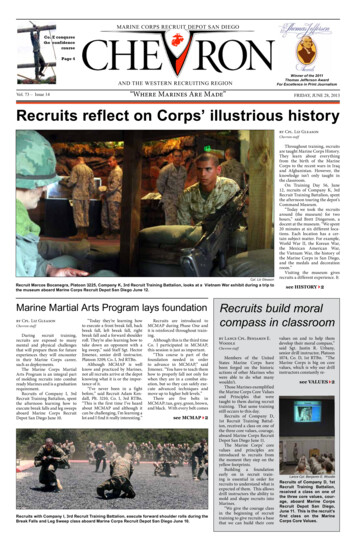


![Welcome [dashdiet.me]](/img/17/30-day-weight-loss-journal.jpg)
